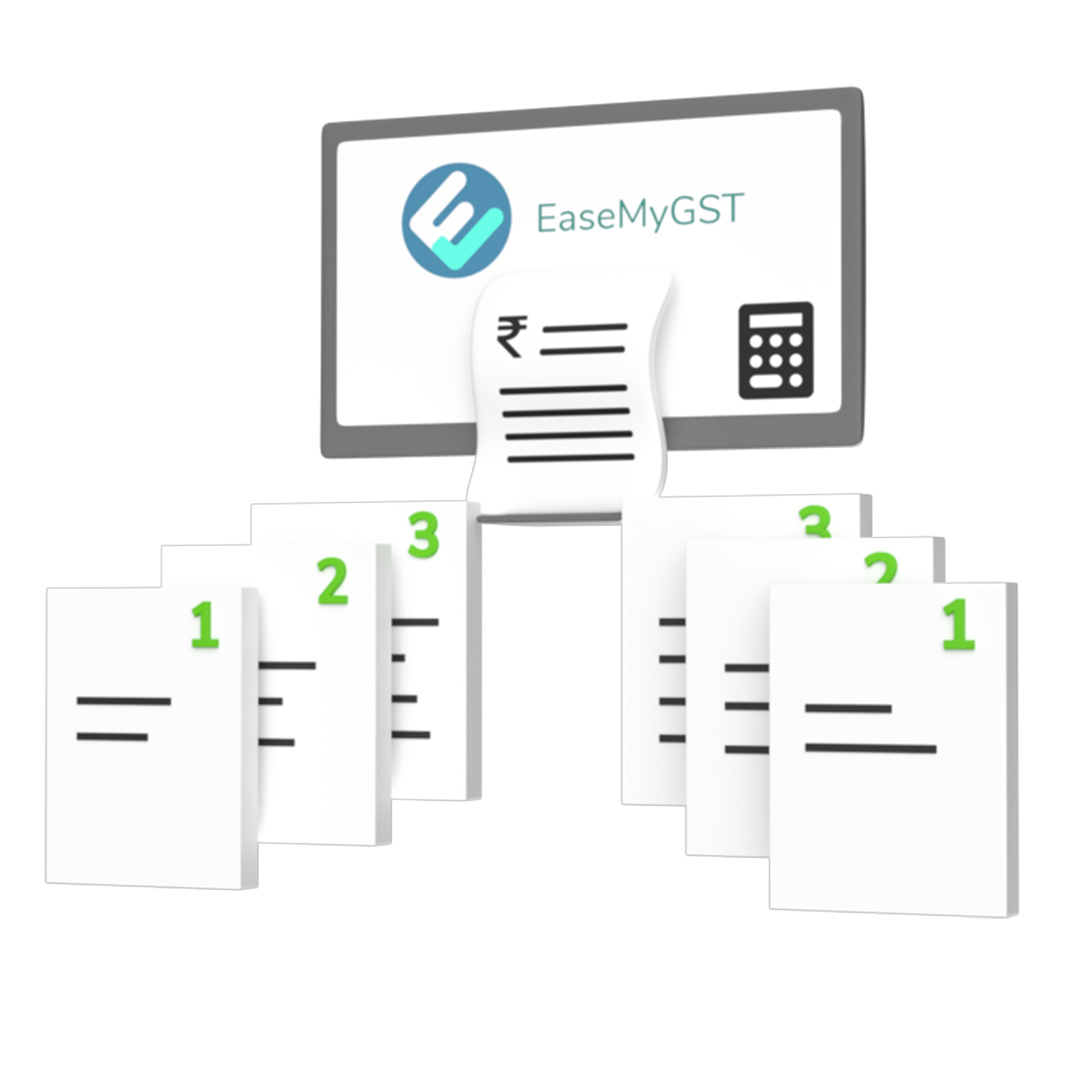E-Way Bill GST – Everything You Need to Know About The E-Way Bill
The implementation of the Goods and Services Tax (GST) in India introduced significant changes to the logistics and transportation of goods. One essential aspect of this system is the E-Way Bill, which serves as a crucial document for the movement of goods across state borders. In this informative article, we will delve into everything you need to know about E-Way Bill under GST.
What is an E-way bill?
E-way bill itself is a document required to be carried by a person in charge of the conveyance carrying any consignment of goods of value exceeding Rs. 50,000/- . The E-way bill generation occurs from the GST Common Portal GSTN, by the registered persons or transporters who cause movement of goods of consignment before the commencement of such movement. When an E-way bill is generated, a unique E- way bill number (EBN) is allocated and is available to the supplier, recipient, and the transporter.

Streamline your e-way bill generation process with efficient GST software from Ginesys
Who can generate the E-way bill?
Every registered person who causes movement of goods of consignment value more than Rs. 50,000/-. If the registered person is unable to generate the e-way bill, the transporter who transports the goods can generate the e-way bill on behalf of his/her client. If the movement is caused by an unregistered person, he may at his option generate the e-way bill under GST.
What are the E-way bill requirements for GST?
The E-Way Bill is a mandatory requirement for the movement of goods exceeding a certain value under the GST regime in India. Here are the key requirements related to E-Way Bill:
- Value Threshold
- Interstate Movement
- Intrastate Movement
- Registration
- Validity Period
- Document Availability
- Exemptions
How can the GST registered taxpayer register for the E-way bill system?
All the registered persons under GST shall also register on the portal of e-way bill namely: ewaybill using his GSTIN. Once the GSTIN has been entered, the system sends an OTP to the registered mobile number and after the authentication, the system enables the taxpayer to generate their username and password for the E-way bill system. Post that, the taxpayer may proceed to make entries for E-way bill generation.
What is the validity period for E-way bill?
Validity of the E-way bill or consolidated E-way bill depends upon the distance the goods have to be transported. The E-way bill validity period in GST is one day up to 100 km and for every 100 km or part thereafter it is one additional day.
Can I extend the validity of the e-way bill?
Yes, one can extend the validity of the e-way bill, if the consignment is not being reached the destination within the validity period due to exceptional circumstance like natural calamity, law and order issues, trans-shipment delay, accident of conveyance, etc. The transporter needs to explain this reason in details while extending the validity period.
How to extend the validity period of e-way bill?
There is an option under the E-way bill to extend the validity period. This option is available for extension of E-way bill before 4 hours and after 4 hours of expiry of the validity. Here, the transporter will enter the e-way bill number and enter the reason for requesting the extension, from a place (current place), the approximate distance to travel, and Part-B details. It may be noted that he cannot change the details of Part-A. He will get the extended validity based on the remaining distance to travel.
Who can extend the validity of the e-way bill?
The transporter, who is carrying the consignment as per the e-way bill system at the time of expiry of validity period, can extend the validity period.
When does the validity of the E-way bill start?
The validity of the E-way bill starts when first entry is made in Part-B i.e. vehicle entry is made first time in case of road transportation or first transport document number entry in case of rail/air/ship transportation, whichever is the first entry. It may be noted that validity is not re-calculated for subsequent entries in Part-B.
What transactions need the E-way bill?
For transportation of goods in relation to all types of transactions such as: Outward supply whether within the State or interstate Inward supply whether from within the State or from interstate including from unregistered persons or for reasons other than supply.
What are the documents that need to be carried along with the goods being transported?
- The person in charge of the conveyance shall carry the following: Tax invoice/bill of supply/delivery challan
- Bill of entry Copy of the E-way bill or the E-way bill number (EBN) that is generated from the common portal GSTN.

Simplify your GST documentation with EaseMyGST, the ultimate e-document generation software for hassle-free compliance
Can the E-way bill be modified or edited?
The e-way bill once generated, cannot be edited or modified. Only Part-B of the bill can be updated. However, if the E-way bill is generated with wrong information, it may be cancelled and generated afresh. The cancellation is required to be done within 24 hours from the time of E-way bill generation.
How does taxpayer enter Part-A details and generate e-way bill, when he is transporting goods himself?
Sometimes, the taxpayer wants to move the goods himself. GST E-way bill Portal expects the user to enter the transporter ID or vehicle number. So, if he wants to move the goods himself, he can enter his GSTIN in the transporter Id field and generate Part A Slip. This indicates to the system that he is a transporter, and he can enter details in Part-B later when transportation details are available.
Is Part-B a must for an e-way bill?
E-Way bill is complete only when Part-B is entered. Otherwise, printout of EWB would be invalid for the movement of goods. Filling up Part-B of the e-way bill is a must for movement of the goods, except for within the same state movement between consignor place to transporter place, the distance is less than 50 Kms.
How to generate E-way bill for multiple invoices belonging to the same consignor and consignee?
If multiple invoices are issued by the supplier to the recipient, that is, for the movement of goods of more than one invoice of same consignor and consignee, multiple E-way Bills have to be generated, i.e., for each invoice, one EWB has to be generated, irrespective of the fact that the same or different consignors and consignees are involved. Multiple invoices cannot be clubbed to generate one EWB.
However after generating all these EWBs, one consolidated EWB can be prepared for transportation purposes, if they are going in one vehicle.
Can the E-way bill be deleted or canceled?
The E-way bill once generated cannot be deleted. However, it can be canceled by the generator within 24 hours of generation. If it has been verified by any proper officer, then it cannot be canceled. Further, e-way bill can be canceled if either good are not transported or are not transported as per the details provided in the e-way bill.
Who can reject the E-way bill and why?
The person who causes transport of goods shall generate the E-way bill specifying the details of another person as a recipient of goods. There is a provision in the common portal for the other party to see the E-way bill generated against his/her GSTIN. As the other party, one can communicate the acceptance or rejection of such consignment specified in the E-way bill.
If the acceptance or rejection is not communicated within 72 hours from the time of generation of e-way Bill, it is deemed that he has accepted the details.
What is a consolidated E-way bill?
Consolidated e-way bill is a document containing the multiple e-way bills for multiple consignments being carried in one vehicle. That is, the transporter, carrying the multiple consignments of various consignors and consignees in one vehicle wherein he is required to carry one consolidated e-way bill instead of carrying multiple e-way bills for those consignments.
What is the validity of a consolidated E-way bill?
Consolidated E-way Bill is like a trip sheet, and it contains details of different EWBs which are moving towards one direction, and these EWBs will have different validity periods. Hence, Consolidated EWB does not have any independent validity period. However, individual consignment specified in the corresponding EWB in the Consolidated EWB should reach the destination as per its validity period of that individual EWB.
What is the advantage of the E-way bill system?
The E-Way bill system intends on abolishing all the check posts across the country for quick and easy movement of goods across India without any hindrance.
Single e-Way Bill for movement of goods throughout the country.
- To prevent tax evasion.
- Hassle-free movement of goods across India.
- Tracking the movement of goods with an E-way Bill number (EBN).
- Easier verification of the E-way Bill by tax officers.
The major benefits of E-way bill system are as follows:
- The traders need not visit tax offices to collect and submit the Way Bill forms as used to be done in the previous (VAT) regimes in some states.
- Average waiting time at the mobile squad reduces drastically – As the verification of the e-Way Bill is done with the common portal, it will speed up the process of verification and allow the vehicle to pass faster.
- Self-policing by traders - a trader while uploading gives the identification of the buying trader who will also account for the transaction automatically.
- Environment friendly – The need for multiple paper copies of the waybill is eliminated. Hence, tons of paper are saved per day.
- Generation of GSTR-1 returns - GSTR 1 return of the supplier is auto-prepared, hence he need not have to upload the same.
- Officials saved from the monotonous work of collecting and matching the manual waybill with the returns of the taxpayers.
All the advantages of the e-way bill can be leveraged properly with an integrated and automated system of e-way bill generation from your current ERP or retail inventory management system.
Ginesys E-Way Bill software for GST compliance is a specialized software solution designed to streamline the process of generating and managing E-Way Bills in accordance with the Goods and Services Tax regulations. Check out the e-way bill software from EaseMyGST that has simplified the process to make it fully automated and verifiable. It is a Ginesys One app for GST compliance with the E-way bill module.


